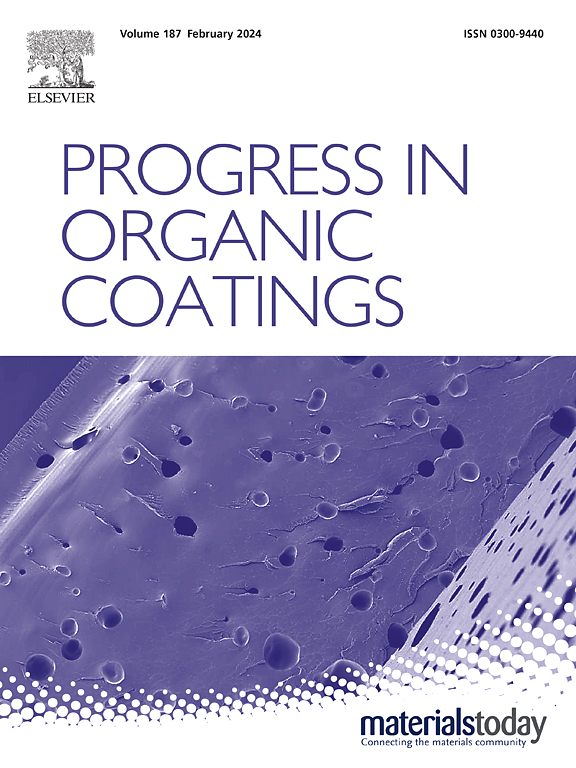Hybrid waterborne polyurethane coating behavior in saline solution
IF 7.3
2区 材料科学
Q1 CHEMISTRY, APPLIED
引用次数: 0
Abstract
Waterborne polyurethane/acrylate (WPUA) dispersion was synthesized via a prepolymer self-emulsifying method, using bisphenol-A-glycidyl dimethacrylate (Bis-GMA) as a chain extender and grafting agent for styrene and butyl acrylate monomers. The degradation of WPUA coatings on mild steel in a 3.5 wt% NaCl solution was investigated through electrochemical impedance spectroscopy and open circuit potential measurements. The water uptake estimated from the Brasher-Kingsbury relation, the intersection of Bode plots (IBP number), and electrical equivalent circuits (ECC) has been analyzed during the degradation process. Particle size (DLS) and morphological (TEM) analyses revealed that the WPUA dispersion exhibited nanometric particle sizes with a core-shell structure. The thermal (TGA/DTG) properties and cross-cut adhesion of the WPUA coatings were greatly enhanced compared to the blank WPU.
Contrary to typical expectations, the impedance modulus in the low-frequency range (lZ0.01Hzl) did not decrease with immersion time for all samples; this effect is attributed to the polymer network characteristics. The degradation mechanisms of the WPUA coatings involve three steps: an initial coating failure as a consequence of the entry of water; in the second step, water absorption continues until a critical level is reached. During this stage, no significant changes in coating resistance were detected. Finally, sudden changes in the monitored parameters indicate the loss of the protective properties.
混合水性聚氨酯涂料在盐水溶液中的性能
以双酚- a -缩水甘油酯二甲基丙烯酸酯(Bis-GMA)为扩链剂和接枝剂,采用预聚物自乳化法制备了水性聚氨酯/丙烯酸酯(WPUA)分散体。采用电化学阻抗谱法和开路电位法研究了低碳钢表面WPUA涂层在3.5 wt% NaCl溶液中的降解。利用brasherr - kingsbury关系、Bode图交集(IBP数)和等效电路(ECC)估算了降解过程中的吸水量。粒径(DLS)和形貌(TEM)分析表明,WPUA分散体具有纳米级的核壳结构。与空白WPU相比,WPUA涂层的热(TGA/DTG)性能和横切附着力得到了极大的提高。与典型的预期相反,所有样品在低频范围(lz0.01 hz)的阻抗模量并没有随着浸泡时间的增加而降低;这种效应归因于聚合物的网络特性。WPUA涂层的降解机制包括三个步骤:由于水的进入,涂层的初始失效;在第二步中,吸水一直持续到达到临界水平。在此阶段,未检测到涂层电阻的显著变化。最后,监测参数的突然变化表明保护性能的丧失。
本文章由计算机程序翻译,如有差异,请以英文原文为准。
求助全文
约1分钟内获得全文
求助全文
来源期刊

Progress in Organic Coatings
工程技术-材料科学:膜
CiteScore
11.40
自引率
15.20%
发文量
577
审稿时长
48 days
期刊介绍:
The aim of this international journal is to analyse and publicise the progress and current state of knowledge in the field of organic coatings and related materials. The Editors and the Editorial Board members will solicit both review and research papers from academic and industrial scientists who are actively engaged in research and development or, in the case of review papers, have extensive experience in the subject to be reviewed. Unsolicited manuscripts will be accepted if they meet the journal''s requirements. The journal publishes papers dealing with such subjects as:
• Chemical, physical and technological properties of organic coatings and related materials
• Problems and methods of preparation, manufacture and application of these materials
• Performance, testing and analysis.
 求助内容:
求助内容: 应助结果提醒方式:
应助结果提醒方式:


